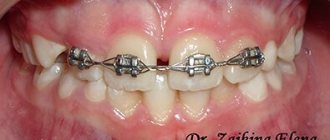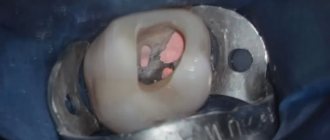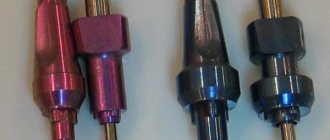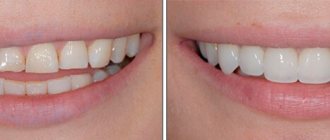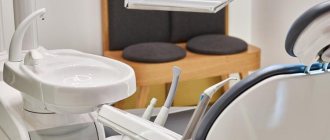Violation of the integrity of the anterior dentition, wide gaps and large fillings cause a cosmetic defect in humans. As a result, he cannot boast of a snow-white smile, and when communicating, he develops an unpleasant habit of covering his mouth with his hand.
Facets are used in dental practice to eliminate cosmetic defects. They allow you to restore lost teeth and give the tooth a natural appearance and original shine.
What is it, purpose
In dentistry, the term facet has a double meaning:
- In the first case, it is defined as an orthopedic structure that imitates a missing tooth by attaching to adjacent crowns. Fastening is carried out using a bridge prosthesis without contact with the gum surface.
- The second meaning of this term is facing material. It is applied to dentures to hide visible defects that arise due to the curvature of the teeth or an increased gap between them. In this case, faceted products act as overlays, which are made of ceramics, porcelain or plastic.
Photos of facets:
applied facets
Unlike plastic, the use of ceramics in the manufacture of onlays allows for better aesthetic results and preservation of the dental unit.
A thin layer of enamel is removed from the tooth surface. In this case, the orthopedic product is installed in one session (without making an impression and wearing temporary prostheses). This is achieved through the use of a special camera, which makes an optical impression of the teeth. After this, a precise design is created in a few minutes on a special milling machine.
The big advantage of this method is the possibility of making a filling or crown. If the patient gives up bad habits, then dental facets placed using this technology can last more than 10 years.
To prevent the crown from standing out from the dentition with its metallic shine, 2 types of veneer are used:
- The facet overlay is applied on the facial side, while the chewing and lingual parts remain uncovered. In this case, the orthopedic product is called straight.
- Reverse facet structures are characterized by covering the entire surface of the artificial tooth unit.
Types of designs and their features
Depending on the type of cladding, direct and reverse facets are distinguished. In the first case, the material is applied only to the visible surface of the prosthesis, in the second, it completely covers it (see photo). The most popular are straight models, which require less time for manufacturing and installation and allow you to quickly restore the integrity of the dentition.
Classification of linings depending on the material used:
- Ceramic. The most popular type of construction, providing the best aesthetic effect. To increase the strength of the model, the visible side is covered with ceramics, the inner side with metal (gold, alloys of silver and palladium, chromium and cobalt).
- Plastic. They have a lower cost and are easy to manufacture. The main disadvantages of the material are rapid erasure and low color fastness. If the manufacturing and operating technology is violated, there is a high probability of plastic breaking off from the cast structure.
Materials used
The following materials are used in production:
- plastic;
- ceramics - zirconium dioxide or pressed porcelain.
Plastic cladding is more affordable, but it is not as durable as ceramic. All-ceramic designs are renowned for their durability. They do not harm the underlying teeth and provide an excellent aesthetic appearance.
Indications and contraindications
Most aesthetic problems can be eliminated with the help of facets if the patient has the following disorders:
- An abnormality of the jaw row, due to which the teeth grow unevenly (crowded or sparse).
- The appearance of cracks as a result of an impact.
- Enamel pigmentation or large fillings.
- As an alternative to bleaching (if other methods have not had the desired effect).
Main contraindications:
- if the patient has bruxism;
- when the dental unit is in the eruption stage;
- severe malocclusion;
- if periodontal disease, periodontitis or gingivitis occurs in an acute form;
- complicated and advanced forms of caries;
- severely damaged teeth (small crown height);
- absence of chewing teeth (more than 6 units);
- practicing hazardous sports (boxing, martial arts).
What is a facet in dentistry?
In dentistry, the term facet has a double meaning:
- In the first case, it is defined as an orthopedic structure that imitates a missing tooth by attaching to adjacent crowns. Fastening is carried out using a bridge prosthesis without contact with the gum surface.
- The second meaning of this term is facing material. It is applied to dentures to hide visible defects that arise due to the curvature of the teeth or an increased gap between them. In this case, faceted products act as overlays, which are made of ceramics, porcelain or plastic.
Dental facets can be safely called artificial teeth. This method is widely used when there are other teeth near the extracted tooth that have already had crowns installed on them. In such cases, it is enough to simply fix the plastic facets, while simultaneously effectively hiding their artificial origin, thereby increasing the aesthetics of the oral cavity.
In addition, a facet is a thin lining that is used to cover the surface of an artificial tooth, covering the defects that have arisen on it. The facet also allows covering the vestibular part of the prosthetic bridge. Specialists are ready to install any types of crowns with a facet, extending it to the chewing surface, and also limiting it only to the sides of the artificial tooth.
A cast tooth with a facet is obtained in almost the same way as dentures with cast teeth, only the laboratory technique used differs. When producing a facet, the doctor carefully selects the correct color so that it subsequently does not differ in any way in the oral cavity.
The production of facets is carried out based on the use of materials such as:
- plastic;
- porcelain.
In dentistry, structures are installed when:
- absence of one dental unit in a row,
- pathological abrasion of tooth enamel,
- multiple fillings and stains on the enamel surface,
- damage to bone tissue,
- changes in enamel color,
- orthodontic defects - crowding or, conversely, sparseness, curvature of the dentition.
What are the advantages and disadvantages of using facets in dentistry?
With quality care, these dental structures can last about 10 years. In addition to ease of manufacture and fixation, the advantages of overlays are:
- natural appearance, indistinguishable from natural dental units,
- the ability to choose a shade to match the color of the dentition,
- strength and resistance to mechanical stress,
- ease of installation compared to prosthetics,
- affordable cost - the opportunity to choose both affordable plastic and more aesthetic ceramics.
This is interesting: Jaw forward - causes and treatment of pushing the lower jaw forward, correcting the bite
Despite its low weight, the facet still puts a load on neighboring dental units. The price of these structures exceeds the cost of filling with light polymer material and requires more time for manufacturing and installation. The disadvantage of models made from quick-hardening plastic is color change under the influence of dyes and ultraviolet radiation.
Indications and contraindications
Most aesthetic problems can be eliminated with the help of facets if the patient has the following disorders:
- An abnormality of the jaw row, due to which the teeth grow unevenly (crowded or sparse).
- The appearance of cracks as a result of an impact.
- Enamel pigmentation or large fillings.
- As an alternative to bleaching (if other methods have not had the desired effect).
Main contraindications:
- if the patient has bruxism;
- when the dental unit is in the eruption stage;
- severe malocclusion;
- if periodontal disease, periodontitis or gingivitis occurs in an acute form;
- complicated and advanced forms of caries;
- severely damaged teeth (small crown height);
- absence of chewing teeth (more than 6 units);
- practicing hazardous sports (boxing, martial arts).
Production and installation of faceted products
Bridge prostheses with cast dental units differ from faceted products only in the laboratory manufacturing technique.
When choosing plastic, a prosthesis with facets can be made in two ways.
- After casting, models with crowns are equipped with fastenings, for which wire branches or loops are used. The soldered crowns are polished, after which they begin to model artificial teeth from wax. Then, using a stamp and a counter-die, a plastic facet is created. To do this, the wax prosthesis is plastered in a ditch (a metal box made of two parts). When the plaster hardens, the wax is washed out under a strong hot jet, and a plastic solution is poured into the resulting cavity, taking into account the selected color. To make a facet prosthesis look aesthetically pleasing, it is carefully polished, giving a natural shine to the enamel.
- Another technique is to create a facet of only the vestibular surface of the orthopedic product, while the rest of the prosthesis is a single casting. In this case, wax is poured between the crowns, followed by the installation of wire loops for fastening. After this, the structure is filled with plaster, and the wax is replaced with metal.
Installation of faceted products in dentistry occurs in compliance with the following steps:
- When examining the oral cavity, the design of the future prosthesis is determined.
- Abutment teeth are processed for the installation of metal crowns.
- Impressions are made, followed by fitting of metal crowns.
- Taking an impression to make a bridge.
- If the bridge prosthesis is made correctly and does not cause the sensation of a foreign body, it is fixed to the supporting teeth with cement.
Prosthetics using onlays are mainly used to restore defects in the anterior jaw row. This occurs in accordance with the sequence of the following steps:
- The choice of composite material is made taking into account the shade of the enamel.
- A thin layer of enamel from 0.5 to 0.7 mm is removed from the front surface.
- Making an impression.
- The finished plate is tried on. If the pad does not cause discomfort, it is cleaned and then fixed with cement paste.
Useful tips
Orthopedic products in the form of facets can last more than 10 years if a person adheres to the following recommendations:
- perform daily oral hygiene;
- give up the bad habit of gnawing seeds and nuts;
- do not abuse foods and drinks that have coloring properties (tea, coffee);
- do not engage in sports that lead to injuries to the facial area.
Features of care
After installing the veneer, the dentist must tell you how to properly care for it so that the structure lasts a long time and does not lose its appearance. The basic rule of care is regular oral cleaning and regular visits to the dentist.
When wearing plywood plates, it is recommended to brush your teeth at least 2 times a day, use dental floss and rinse your mouth after every meal. Due to some foods, the material of the dishes becomes opaque, so do not overuse strong coffee, tea, red wine or smoke. Twice a year you should contact your dentist for professional cleaning, which will help maintain the aesthetic appearance of the veneer.
How to replace facets
Faceted plastic products can be damaged by chipping. In this case, the product loses its cosmetic value.
To restore integrity, the direct modeling method is used. In this case, the nest of the facet design is completely cleaned, followed by disinfection. The resulting bed is filled with a plastic solution, having previously selected it by color. When it begins to harden, it is compacted and the tooth is given the desired shape. Upon completion, the dental unit is ground, and the surface of the plastic is coated with a special varnish.
Patients who have had orthopedic products installed in the form of facets note that they are no different from natural teeth. In this case, you have the opportunity to choose the desired color.
But this dental procedure has a significant disadvantage - high cost. So in economy class clinics the price for one unit (using ceramic facing material) is within 14,000 rubles.
This does not make this procedure accessible to the public, and therefore people with limited financial resources are deprived of the opportunity to undergo prosthetics using facets.
Advantages and disadvantages of dental facets
Using faceted coating has a number of advantages:
- offers a pleasant smile.
- material strength;
- helps hide dental defects;
- quick installation;
- in appearance does not differ from natural teeth;
Despite its advantages, veneer reconstruction technology has its drawbacks. For example, a plastic plate becomes dull over time and requires replacement. If there is no dental unit in the row, the coating does not replace it, but only covers this place, which affects the functioning of the dental system.



